The AMD Ryzen Threadripper 1950X and 1920X Review: CPUs on Steroids
by Ian Cutress on August 10, 2017 9:00 AM EST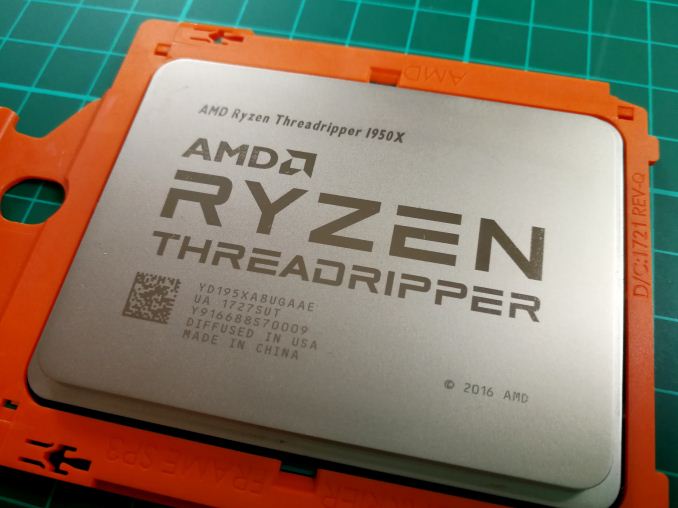
In the early 2000s, we had the battle to high frequencies. The company that could force the most cycles through a processor could get a base performance advantage over the other, and it led to some rather hot chips, with the certain architectures being dropped for something that scaled better. Move on 10-15 years and we are now at the heart of the Core Wars: how many CPU cores with high IPC can you fit into a consumer processor? Up to today, the answer was 10, but now AMD is pushing the barrier to 16 with its new Threadripper processors. We got both of the launch CPUs for review and put them on the grill.
The New World Order
Earlier in the year, AMD launched their new CPU microarchitecture, Zen. This was implemented into the Ryzen series of CPUs, aiming squarely at Intel’s high-end desktop market first. The three members of the Ryzen 7 family all had eight cores with hyperthreading, and scored highly in performance per dollar, achieving performance near comparable Intel processors at half the price (or better). Next came four Ryzen 5 CPUs, competing in price against the quad core i5 parts, and for that price Ryzen 5 had twelve threads, triple that of Core i5. Finally Ryzen 3 hit the ~$120 market against the Core i3s, with double the cores over Intel. We also saw AMD’s EPYC family officially launch into the enterprise space, offering up to 32 cores, and is being rolled out over the next few months as OEMs and customers test and scale their performance.
- The AMD Zen and Ryzen 7 Review: A Deep Dive on 1800X, 1700X and 1700
- The AMD Ryzen 5 1600X vs Core i5 Review: Twelve Threads vs Four at $250
- The AMD Ryzen 3 1300X and Ryzen 3 1200 CPU Review: Zen on a Budget
- Intel's Skylake-SP Xeon versus AMD's EPYC 7000 - The Server CPU Battle of the Decade
Out of the gate today is AMD’s Ryzen Threadripper family, or Threadripper for short. These CPUs take a similar design as the AMD EPYC processors, but for a consumer platform. The first two CPUs are the 1950X and 1920X, with 16 and 12 cores respectively, to be then followed by the 8 core 1900X on August 31st, and the 1920 at sometime unknown. These parts will fit into the LGA-style TR4 socket, containing 4094-pins. This socket is identical (but not interchangeable) to the SP3 socket used for EPYC, and a large step over the 1331-pin PGA-style AM4 socket for the Ryzen 7/5/3 processors.
| AMD Ryzen SKUs | |||||||||
| Cores/ Threads |
Base/ Turbo |
XFR | L3 | DRAM 1DPC |
PCIe | TDP | SRP | Cooler | |
| TR 1950X | 16/32 | 3.4/4.0 | +200* | 32 MB | 4x2666 | 60 | 180W | $999 | - |
| TR 1920X | 12/24 | 3.5/4.0 | +200* | 32 MB | 4x2666 | 60 | 180W | $799 | - |
| TR 1920** | 12/24 | 3.2/3.8 | ? | 32 MB | 4-Ch? | 60 | 140W | ? | - |
| TR 1900X | 8/16 | 3.8/4.0 | +200 | 16 MB* | 4x2666* | 60 | 180W* | $549 | - |
| Ryzen 7 1800X | 8/16 | 3.6/4.0 | +100 | 16 MB | 2x2666 | 16 | 95 W | $499 | - |
| Ryzen 7 1700X | 8/16 | 3.4/3.8 | +100 | 16 MB | 2x2666 | 16 | 95 W | $399 | - |
| Ryzen 7 1700 | 8/16 | 3.0/3.7 | +50 | 16 MB | 2x2666 | 16 | 65 W | $329 | Spire |
| Ryzen 5 1600X | 6/12 | 3.6/4.0 | +100 | 16 MB | 2x2666 | 16 | 95 W | $249 | - |
| Ryzen 5 1600 | 6/12 | 3.2/3.6 | +100 | 16 MB | 2x2666 | 16 | 65 W | $219 | Spire |
| Ryzen 5 1500X | 4/8 | 3.5/3.7 | +200 | 16 MB | 2x2666 | 16 | 65 W | $189 | Spire |
| Ryzen 5 1400 | 4/8 | 3.2/3.4 | +50 | 8 MB | 2x2666 | 16 | 65 W | $169 | Stealth |
| Ryzen 3 1300X | 4/4 | 3.5/3.7 | +200 | 8 MB | 2x2666 | 16 | 65 W | $129 | Stealth |
| Ryzen 3 1200 | 4/4 | 3.1/3.4 | +50 | 8 MB | 2x2666 | 16 | 65 W | $109 | Stealth |
* New information from AMD from our last piece
** Unannounced product, specifications subject to change
Where Ryzen 7 was aiming for Intel’s high-end desktop (HEDT) market share, Threadripper is designed to go above and beyond this, into a ‘super high-end desktop’ market (SHED). The core counts that AMD are releasing with Threadripper were only traditionally seen on Intel’s server line, which features up to 28 cores for a $10000 outlay. By bringing higher-core count parts, with reasonable IPC, frequency, and power numbers, AMD is fudging the line between consumer, prosumer, and enterprise. To compete, Intel announced that their Skylake-X platform will be coming out with 12, 14, 16 and 18 core parts over the next few months.
Similar to Intel’s biggest chips, AMD is aiming Threadripper into the hands of users who want to do everything all the time. For home users, that might mean gaming while streaming (transcoding and uploading in real-time) while also hosting a game server and all other things besides. For prosumers it means video production or compute throughput using several GPUs/FPGAs mixed in with fast storage and networking. The idea is that if the user has something that needs doing, they can also use their system to do other things at the same time and have sufficient CPU grunt, PCIe slots, storage, and DRAM to power it all. Threadripper is, after all, derrived from a design for a server CPU, and accordingly it never strays too far from the high performance-density aspects that have defined servers over the last decade.
New Socket, New Motherboards
Again, similar to Intel’s HEDT platform, AMD is launching the X399 platform alongside Threadripper to provide the necessary tools. The large TR4 socket and all of its pins gives quad-channel memory with two DIMMs per channel, along with up to 60 PCIe lanes for add-in cards (Video cards, NICs, SSDs, etc). These motherboards currently support the two Threadripper CPUs launched today, one more CPU to be launched at the end of the month, and another CPU that has been leaked but not announced (with an unknown release date).
The socket is different to previous AMD sockets, showcasing how much of a step up this is. Rather than a PGA socket with a simple latch system to provide enough force between the pads and pins, the LGA TR4 socket has three Torx screws that should be removed in order – one on the left of the picture above and two on the right. The socket bracket immediately flips open, with a small tray – this tray takes the CPU. All of the Threadripper CPUs will come in this little tray, and there’s no need to take it out of the tray.
Because of the design of the socket and the size of the CPUs, the screw holes for CPU coolers are different as well. As each CPU is currently geared for 180W, AMD recommends liquid cooling at a bare minimum, and will bundle an Asetek CPU bracket with every CPU sold (a Torx screwdriver is also supplied).
The bracket is narrower on one end, which indicates the ‘top’ of the socket in a traditional motherboard shot.
A total of six motherboards from the four main manufacturers should be available on day one, with at least one or two more coming down the pipe. Our own Joe Shields has written an extensive preview of each motherboard to accompany this article.
The crux of the motherboard design will be down to how each of the available IO functions is routed. AMD’s base block diagram is as follows:
AMD's suggested configuration gives 48 lanes from the CPU to the PCIe slots for 4-way SLI/CFX action (16/16/8/8), 12 lanes from the CPU to M.2 slots for 3-way x4 NVMe, and 4 lanes to the chipset. The chipset then would have two gigabit Ethernet ports, a PCIe x4 slot, a PCIe x1 slot, a PCIe x1 for WiFi, SATA ports, USB 3.1 Gen 1 and USB 3.1 Gen 2, and USB 2.0 ports.
At present we expect the X399 motherboards to vary between $249 and $599, depending on their feature set. The motherboard we were sampled for the launch review was ASUS’ X399 ROG Zenith Extreme, which has an MSRP of $549.
Competition
We asked both Intel and AMD to list what they consider would be the ideal competition for the Threadripper processors. Given that Threadripper is a consumer focused product – and interestingly, not really a workstation focused product – AMD expectantly stated that Intel’s current Core i9-7900X, a 10-core processor, is the product available today that best fits that role. A Xeon would be an workstation/enterprise product, which would not be sold in many prebuilt systems that Threadripper customers might want.
Intel surprised me, in saying exactly the same thing. They stated that the Core i9-7900X would be the best fit at the time of Threadripper’s launch. I half-expected them to suggest some form of cheaper 2P option, although when I followed them up as to why they didn’t suggest such a thing, it became obvious for two reasons: firstly, Intel’s Consumer and Intel’s Enterprise divisions are almost different companies with little crossover or insight into the other’s business. There are no unified press relations on this front: ask the consumer team, get the consumer answer. Ask the Enterprise team and they’re more focused on EPYC, not Threadripper. The second reason is that a ‘cheap 2P’ system doesn’t exist when you buy new – most online discussions about cheaper Intel 2P systems revolve around finding CPU bargains from the gray market or resellers.
So the competition is essentially Skylake-X (and a nod to Broadwell-E at a discount). The AMD Threadripper 1950X with 16-cores and 1920X with 12-cores are put up against the Core i9-7900X with 10-cores and the Core i7-7820X with 8 cores. Broadwell’s Core i7-6950X also makes an appearance due to the different microarchitecture. We’ll add in AMD’s Ryzen 7 1800X as a contender as well, and Ryzen 7 1700 as a performance per dollar competitor.
| The Battle | |||||||||
| Cores/ Threads |
Base/ Turbo |
XFR | L3 | DRAM 1DPC |
PCIe | TDP | Cost (8/10) |
||
| AMD | TR 1950X | 16/32 | 3.4/4.0 | +200 | 32 MB | 4x2666 | 60 | 180W | $999 |
| Intel | i9-7900X | 10/20 | 3.3/4.3 | +200 | 13.75 | 4x2666 | 44 | 140W | $980 |
| Intel | i7-6950X | 10/20 | 3.0/3.5 | +500 | 25 MB | 4x2400 | 40 | 140W | $1499 |
| AMD | TR 1920X | 12/24 | 3.5/4.0 | +200 | 32 MB | 4x2666 | 60 | 180W | $799 |
| Intel | i7-7820X | 8/16 | 3.6/4.3 | +200 | 11 MB | 4x2666 | 28 | 140W | $593 |
| AMD | TR 1900X | 8/16 | 3.8/4.0 | +200 | 16 MB | 4x2666 | 60 | 180W | $549 |
| AMD | R7 1800X | 8/16 | 3.6/4.0 | +100 | 16 MB | 2x2666 | 16 | 95 W | $419 |
| AMD | R7 1700X | 8/16 | 3.4/3.8 | +100 | 16 MB | 2x2666 | 16 | 95 W | $350 |
| AMD | R7 1700 | 8/16 | 3.0/3.7 | +50 | 16 MB | 2x2666 | 16 | 65 W | $291 |
The key here is that Threadripper has more cores and more PCIe lanes at the same price, with a lower turbo but a higher base frequency, at slightly more power for similar platform costs. It’s going to be an interesting battle.
Pages In This Review
- 1: AMD Ryzen Threadripper 1950X and 1920X
- 2: Feeding the Beast and CPU Top Trumps
- 3: Silicon, Glue, & NUMA Too
- 4: AMD’s Solution to Dual Dies: Creator Mode and Game Mode
- 5: Test Bed and Setup
- 6: Benchmark Overview
- 7: Benchmarking Performance: CPU System Tests
- 8: Benchmarking Performance: CPU Rendering Tests
- 9: Benchmarking Performance: CPU Web Tests
- 10: Benchmarking Performance: CPU Encoding Tests
- 11: Benchmarking Performance: CPU Office Tests
- 12: Benchmarking Performance: CPU Legacy Tests
- 13: Gaming Performance: Civilization 6 (1080p, 4K, 8K, 16K)
- 14: Gaming Performance: Ashes of the Singularity Escalation (1080p, 4K)
- 15: Gaming Performance: Shadow of Mordor (1080p, 4K)
- 16: Gaming Performance: Rise of the Tomb Raider (1080p, 4K)
- 17: Gaming Performance: Rocket League (1080p, 4K)
- 18: Gaming Performance: Grand Theft Auto V (1080p, 4K)
- 19: Power Consumption and Efficiency
- 20: Analyzing Creator Mode and Game Mode
- 21: Conclusions and Final Words
Additional Review Notes
Due to circumstances beyond our control, this review has no Skylake-X gaming data. At the time of our SKL-X review, it was throwing up some issues and so we aimed to test at a later date. We ran some more data using the latest BIOS and a more stringent cooling setup, then when Threadripper arrived we packed the SKL-X away and Threadripper took the phsyical place of SKL-X in the lab. Having had time to look back at our SKL-X results and now process them, we had one CPU+GPU combo that seemed to perform as expected but the rest were still erroneous. Once this review is out of the way and a couple of mini-projects, we're going to update the X299 motherboard with a new one and knuckle down to find this issue, as it appears to be BIOS/firmware related.


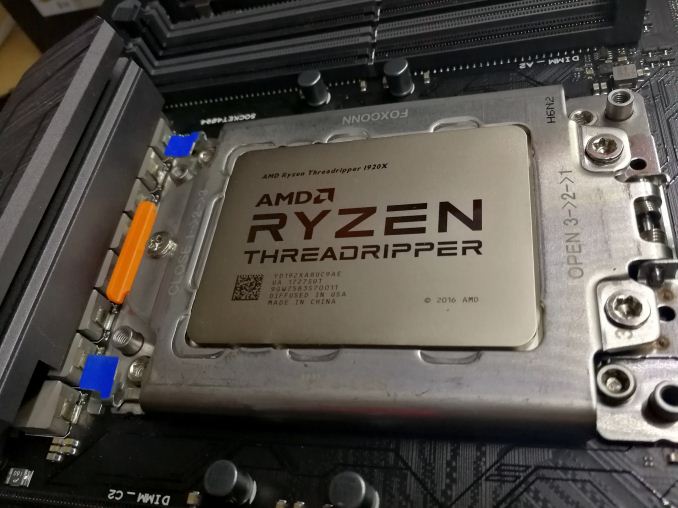
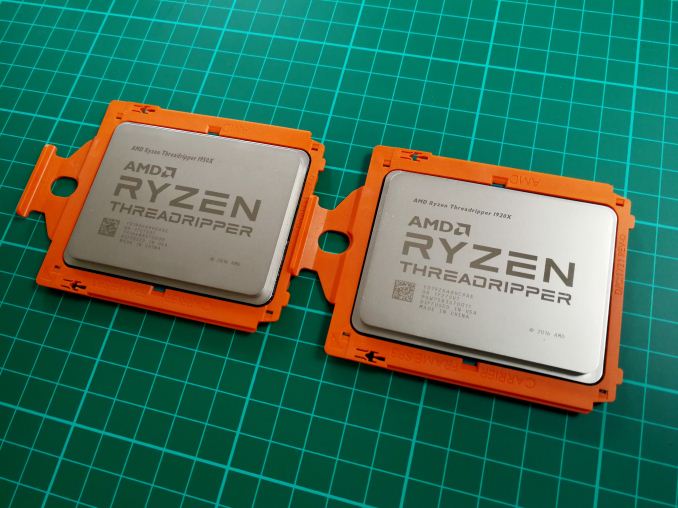
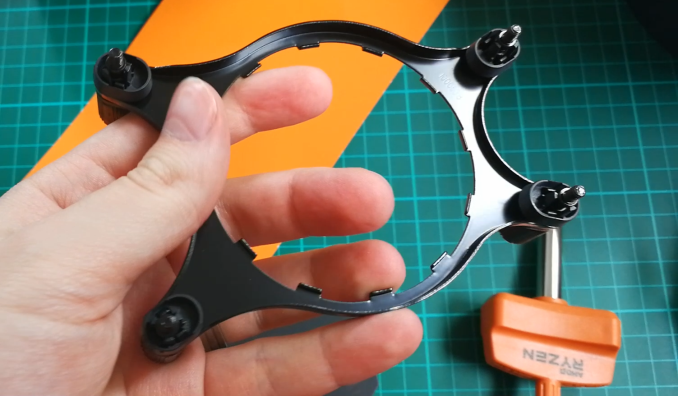
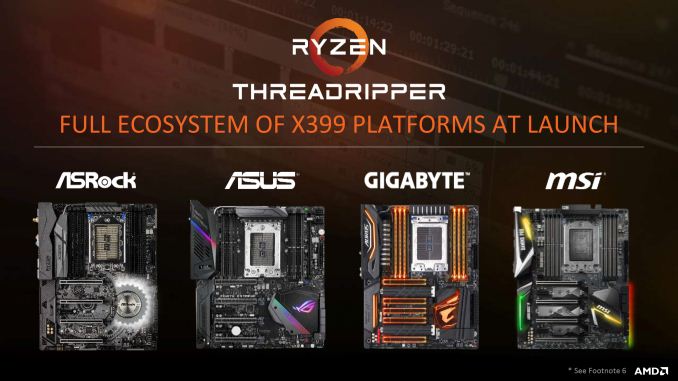
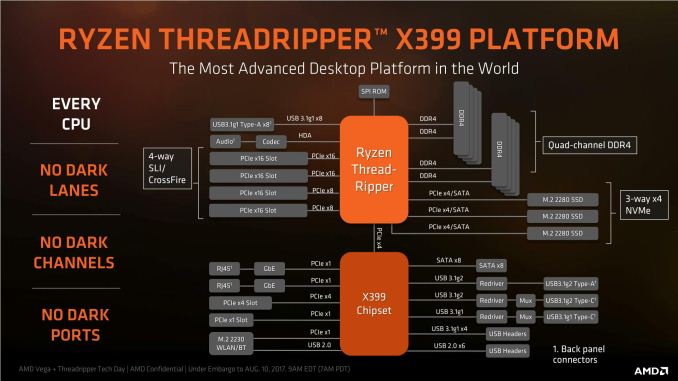








347 Comments
View All Comments
sorten - Friday, August 11, 2017 - link
Swole? Threadripped?Rottie - Friday, August 11, 2017 - link
AMD Ryzen CPU is not fast enough. Apple is not ready for AMD Ryzen CPU, sorry AMD. I love AMD but I hated Intel even though I have a Skylake based MacBook Pro. :(Deshi! - Friday, August 11, 2017 - link
One small correction, Ryzen has 24 PCIE lanes, not 16. it has 16 for graphics only, but saying only 16 may make people (like me) wonder if you can't run an NVME at x4 and still have the graphics card at 16x, which you totally can do.Deshi! - Friday, August 11, 2017 - link
This is under Feeding the beast section btw, where you said "Whereas Ryzen 7 only had 16 PCIe lanes, competing in part against CPUs from Intel that had 28/44 PCIe lanes,"fanofanand - Tuesday, August 15, 2017 - link
He already answered this question/statement to someone else. there are 20 lanes from the CPU, 16 of which are available for graphics. I don't think his way of viewing it seems accurate, but he has stated that this is how PCIe lanes have been counted "for decades"WaltC - Friday, August 11, 2017 - link
Nice review, btw! Yes, going all the way back to Athlon and the triumph of DDR-Sdram over Rdram, and the triumph of AMD's x86-64 over Itanium (Itanium having been Intel's only "answer" for 64-bit desktop computing post the A64 launch--other than to have actually paid for and *run* an Intel ad campaign stating "You don't need 64-bits on the desktop", believe it or not), and going all the way back to Intel's initial Core 2 designs, the products that *actually licensed x86-64 from AMD* (so that Intel could compete in the 64-bit desktop space it claimed didn't exist), it's really remarkable how much AMD has done to enervate and energize the x86 computing marketplace globally. Interestingly enough it's been AMD, not Intel, that has charted the course for desktop computing globally--and it goes all the way back to the original AMD Athlon. The original Pentium designs--I owned 90MHz and 100MHz Pentiums before I moved to AMD in 1999--were the high-point of an architecture that Intel would *cancel* shortly thereafter simply because it could not compete with the Athlon and its spin-off architectures like the A64. That which is called "Pentium" today is not...;) Intel simply has continued to use the brand. All I can say is: TGF AMD...;) I've tried to imagine where Intel would have taken the desktop computing market had consumers allowed the company to lead them around by the nose, and I can't...;) If not for AMD *right now* and all the activity the company is bringing to the PC space once again, there would not be much of a PC market globally going on. But now that we have some *action* again and Intel is breaking its legs trying to keep up, the PC market is poised to break out of the doldrums! I guess Intel had decided to simply nap for a few decades--"Wake me when some other company does something we'll have to compete with!" Ugh.zeroidea - Friday, August 11, 2017 - link
Hi Ian,On the Civ 6 benchmark page, all results after the GTX 1080 are mislabeled as GTA 6.
Ahmad Rady - Friday, August 11, 2017 - link
Can you try to test this CPU using windows server?This is a MCM CPU looks like 4 CPUs attached to each other.
I think windows 10 Pro can't get the most of this CPU unless we have windows 10 Pro for WS
Pekish79 - Friday, August 11, 2017 - link
Vray has a Rendering Benchmark too maybe you could use bothPekish79 - Friday, August 11, 2017 - link
I went to check both page of Vray and Corona BenchmarkCorona match more or less the graphic and Vray has the following
AMD 1950 : 00:46-00:48 sec
I9 7900: 00:54-00:56 sec
I7 6950: 01:00-01:10 sec
I5 5960: 01:23-01:33 sec